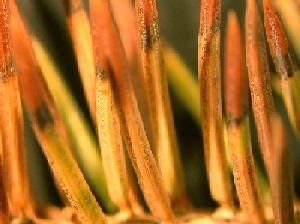Needlecast Disease of Spruce: One Possible Explanation for Browning Spruce Needles
A common problem encountered on spruce trees is browning of the needles. There are a number of possible causes, but one that is frequently a problem in Manitoba is needle disease. Two fungi commonly observed in association with diseased needles in Manitoba are Stigmina lautii, variously referred to as Stigmina needlecast or Stigmina needle blight, and Rhizosphaera kalkhoffii , causal agent of Rhizosphaera needlecast. Stigmina is the fungus most commonly encountered in association with diseased spruce samples submitted to the Manitoba Crop Diagnostic Centre but both diseases are known to occur here.
When the needles are examined closely, tiny black fruiting bodies can be seen replacing the normally white stomates (breathing pores) of the needle and arranged in lines along the length of the needle (See Figure 1). Both Stigmina and Rhizosphaera produce similar symptoms and close examination with a magnifying lens is needed to determine positively which fungus is present. Fruiting bodies of Stigmina appear fuzzy or feathery whereas fruiting bodies of Rhizosphaera appear spherical or rounded and smooth. The fruiting bodies can be observed on needles that are still green, needles that are in process of discolouring or dead needles. Stigmina and Rhizosphaera are primarily seen as a disease of blue spruce (Picea pungens), but white spruce (Picea glauca) can also be affected. Needle disease can be a significant problem in Christmas tree plantations, where it can greatly reduce the attractiveness and the value of the trees, but can be a concern in shelterbelts and urban landscapes as well.

Figure 1: Needles showing fungus fruiting bodies as black specks on the surface of the needle. Further magnification would be necessary to determine whether the fungus is Stigmina or Rhizosphaera. Infection of these needles would have occurred in the previous growing season.
With a disease cycle that lasts longer than one season, disease management is a challenge. Infection usually takes place in the spring with symptoms not becoming visible for a full year or longer. Thus an outbreak of symptoms this year, is actually the result of suitable conditions and infection in the spring of the previous year. Years with greater than normal spring rainfall are favourable for Stigmina and Rhizosphaera. Under high disease pressure, loss of needles on entire branches and multiple branches, is possible. Symptoms are usually first observed on lower branches but over consecutive seasons the disease can progress upward on the trees. After several successive seasons of needle loss, affected trees are severely weakened and the tree may die.
To reduce the risk of injury from needlecast outbreaks, fungicides are often necessary to protect new uninfected growth. In Canada, two fungicides with active ingredient of copper oxychloride have a general registration for needlecast diseases and several other fungicides have registration specifically for control of Stigmina or Rhizosphaera (See Table 1). Generally, late May to early June (about 1-5 cm of new growth) is the time to begin applying these products but follow the specific instructions of the label of the chosen product carefully if fungicides are to be applied.
Table 1: List of Products registered in Canada for use against needle diseases of spruce in general or specifically for Stigmina or Rhizosphaera.
| Fungicide Active Ingredient | Trade Name | PCP#* | Disease Controlled | Registration Type** | |||
|---|---|---|---|---|---|---|---|
| chlorothalonil | Bravo Ultrex | 29306 | Rhizosphaera | commercial | |||
| Bravo Ultrex 90 SDG | 24793 | Rhizosphaera | commercial | ||||
| Daconil 2787 | 15724 | Rhizosphaera | commercial | ||||
| Daconil 720 | 30165 | Rhizosphaera | commercial | ||||
| Echo 720 | 29335 | Rhizosphaera | commercial | ||||
| Echo 90DF | 29356 | Rhizosphaera | commercial | ||||
| copper oxychloride | Copper oxychloride 50 | 13245 | needlecast diseases and twig blights | commercial | |||
| Copper Spray | 19146 | needlecast diseases and twig blights | commercial | ||||
| propiconazole | Banner MAXX*** | 27003 | Rhizosphaera, Stigmina | commercial | |||
| trifloxystrobin | Flint*** | 30619 | Rhizosphaera, Stigmina | commercial | |||
* PCP - Pest Control Products Act registration number, each pesticide has a unique identifying number.
** Products registered for commercial purposes are intended for use by commercial applicators only, not by individual homeowners. There are currently no products for needle disease with domestic registration for application by invidual homeowners.
*** For use in Christmas tree nurseries only, not for use on ornamental trees.
In conjunction with the use of fungicides, mowing of grass around the trees to keep humidity levels low, removal of all fallen needles away from the base of tree (to reduce levels of the pathogen), and avoiding pruning or shearing of trees during wet weather ( to avoid spreading spores of the fungus), will also reduce the impact of needlecast disease. When pruning or shearing, at any time, tools should be sterilized between cuts by dipping in 70% alcohol for 3 minutes.
Needle disease is one explanation for the browning of needles in spruce but there can be other factors to consider such as environmental and site factors, insect infestations and stem diseases. Be sure to have an accurate diagnosis prior to starting a control program for needle disease.
For further information on Stigmina or Rhizosphaera needlecast see the references below.
References
- Hansen, E.M and Lewis, K.J. 1997. Compendium of Conifer Diseases. St. Paul: APS Press.
- Walla, J.A. and Kinzer, K.M. 2008. Symptoms and signs of Stigmina lautii on spruce needles in North Dakota. Abstract. 2008 APS Centennial Meeting.
For further information, contact ARD/MASC Service Centre
